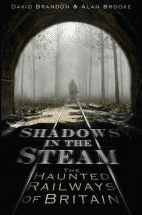 Shadow in the Steam: "The Haunted Railways of Britain"
Shadow in the Steam: "The Haunted Railways of Britain"
by David Brandon and Alan Brooke
This book contains 189 pages dedicated to the haunted steam railways of Britain. A five page introduction covers religious philosophy of life after death, some theories why a ghost appears and the place the paranormal has in our literature. M.R. James and the academic studies of Owen Davies are also mentioned. An account of the paranormal in film T.V. and literature reoccurs in the final few chapters of the book.
We are all aware that the paranormal has been used as a subject for various genres of entertainment. However, what I found of particular interest was the sheer number of films made on the subject during the early years of the cinema. The book contains accounts of the haunted railways of half of the countries of England, and also a few from Scotland and Wales. For London based readers there is a rather interesting page on the long gone terminus called ‘Addiscombe’. This book contains a mass of historical information on the buildings and creation of railways in Britain, with a number of photographs of stations and railway lines. Railway disasters are also mentioned, such as the Tay Bridge collapse of 1879 and the ghost train that was reported to have been seen there.
In 1887 a driver on the Sheffield to Doncaster line, over ran a signal, and crashed in to the rear of a special train going to the Doncaster races. After the tragic event ghostly re-enactments where reported with the ghosts of the victims also being seen. The authors add an interesting theory to the disaster. ‘There is a theory that the concentration of emotion released by events can imbue the locality with an energy that leads to such re-enactments this energy is thought to dissipate over time, and there have been no reports of such activity for many years’.
The London underground is also mentioned in three chapters: - ‘Ghosts of the Underground’ ‘The development of the London Underground’ and ‘defunct underground stations.’ The author’s thourough knowledge of railway history is displayed throughout the pages, making this book an interesting addition to any railway historian, or serious collector of ghost books.
Reviewed by Greg Morgan


